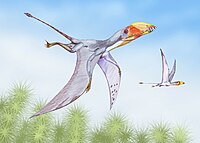Dimorphodon: Difference between revisions
No edit summary |
m robot Adding: pt:Dimorphodon |
||
| Line 45: | Line 45: | ||
[[Category:Jurassic pterosaurs]] |
[[Category:Jurassic pterosaurs]] |
||
[[Category:Prehistoric reptiles of Europe]] |
[[Category:Prehistoric reptiles of Europe]] |
||
| ⚫ | |||
[[ca:Dimorphodon]] |
[[ca:Dimorphodon]] |
||
| Line 54: | Line 56: | ||
[[ja:ディモルフォドン]] |
[[ja:ディモルフォドン]] |
||
[[pl:Dymorfodon]] |
[[pl:Dymorfodon]] |
||
[[pt:Dimorphodon]] |
|||
[[simple:Dimorphodon]] |
[[simple:Dimorphodon]] |
||
[[sk:Dimorphodon]] |
[[sk:Dimorphodon]] |
||
| Line 59: | Line 62: | ||
[[vo:Dimorphodon]] |
[[vo:Dimorphodon]] |
||
[[zh:雙型齒翼龍]] |
[[zh:雙型齒翼龍]] |
||
| ⚫ | |||
Revision as of 05:06, 11 October 2008
| Dimorphodon Temporal range: Early Jurassic
| |
|---|---|

| |
| Scientific classification | |
| Kingdom: | |
| Phylum: | |
| Class: | |
| Order: | |
| Suborder: | |
| Family: | |
| Genus: | Dimorphodon Owen, 1859
|
| Species | |
|
D. macronyx (Buckland, 1829)(type) | |
Dimorphodon daiˈmɔː(r)f.ə.dɑn ("Two-form Teeth") was a genus of medium-sized (wing span 1.6 m., length of skull 22 cm.) pterosaur from the Early Jurassic Period (180-170 million years ago). It was named by paleontologist Richard Owen in 1859. Dimorphodon means "two-form tooth" (Greek δι/di meaning 'two', μορφη/morphe meaning 'shape' and οδον/odon meaning tooth), referring to the fact that it had two distinct types of teeth in its jaws - which is comparatively rare among reptiles.

It had a large, bulky skull whose weight was reduced by large cavities separated from each other by thin bony partitions. Its structure, reminiscent of the supporting arches of a bridge, prompted Richard Owen to declare that, in far as achieving great strength from light-weight materials was concerned, no vertebrae was more economically constructed. Otherwise, of course, the body structure of Dimorphodon displays many primitive characters, such as a very small brain-pan. The neck was strong and flexible and may have had a membraneous pouch on the under side.
Our knowledge of how Dimorphodon lived is also very small. It probably inhabited coastal regions and had a very varied diet.
Fossil remains have been found in England. Mary Anning made the first Dimorphodon (D. macronyx) discovery, at Lyme Regis in Dorset, UK in 1828.[1] This region of Britain is now a World Heritage Site, dubbed the Jurassic Coast. Dimorphodon was approximately 1 metre (3.3 ft) long, with a 1.4 meter (4.6 ft) wingspan.[2]

It has been argued that Dimorphodon was a biped, though fossilised track remains of other pterosaurs (ichnites) show a quadrupedal gait while on the ground. Its teeth and jaws suggest it was, like most pterosaurs, a piscivore (fish eater), although until quite recently it was suggested that it hunted small land animals. Most depictions give it a puffin-like 'beak'.
Dimorphodon lived approximately 200 million to 180 million years ago.
See also
References
- Benes, Josef. Prehistoric Animals and Plants. Pg. 158. Prague: Artia, 1979.
- ^ Wellnhofer, Peter (1996) [1991]. The Illustrated Encyclopedia of Pterosaurs. New York: Barnes and Noble Books. p. 69. ISBN 0-7607-0154-7.
- ^ Wellnhofer, Peter (1996) [1991]. The Illustrated Encyclopedia of Pterosaurs. New York: Barnes and Noble Books. p. 71. ISBN 0-7607-0154-7.
External links
- Dimorphodon macronyx at the Pterosaur Database
